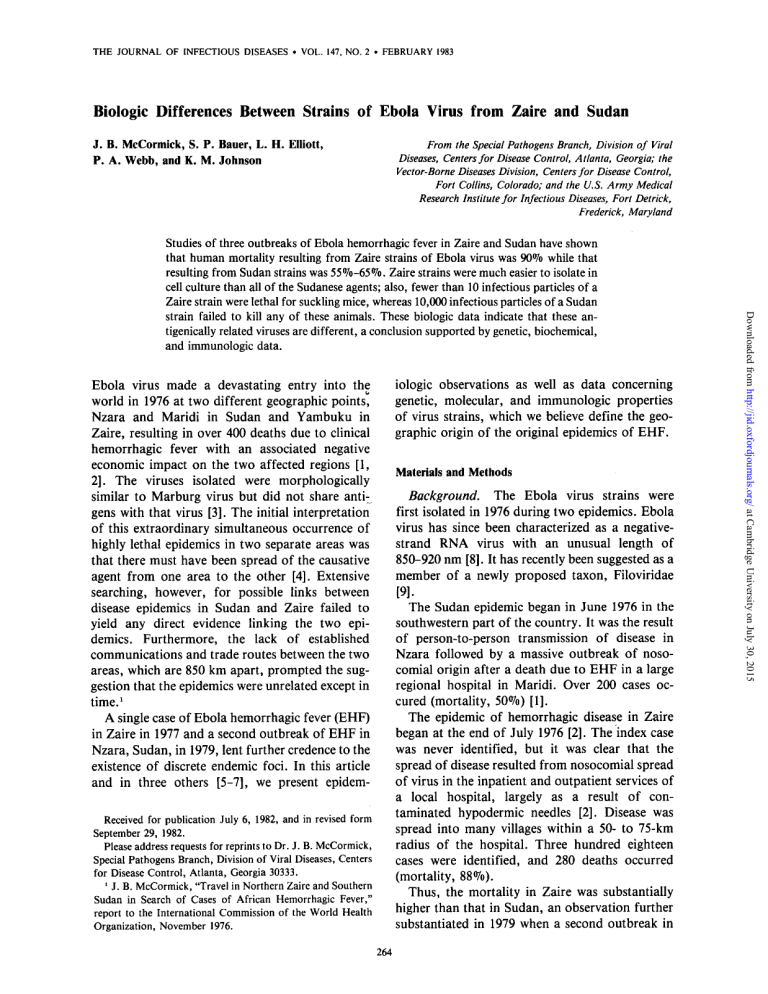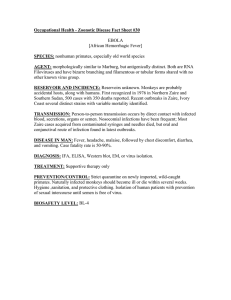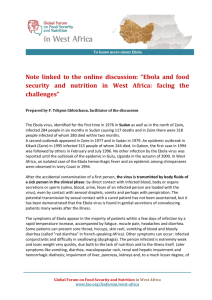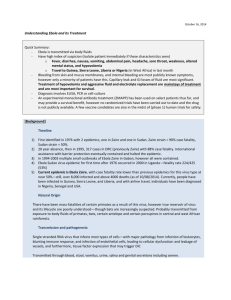
THE JOURNAL OF INFECTIOUS DISEASES. VOL. 147, NO.2. FEBRUARY 1983 Biologic Differences Between Strains of Ebola Virus from Zaire and Sudan J. B. McCormick, S. P. Bauer, L. H. Elliott, P. A. Webb, and K. M. Johnson From the Special Pathogens Branch, Division of Viral Diseases, Centers for Disease Control, Atlanta, Georgia; the Vector-Borne Diseases Division, Centers for Disease Control, Fort Collins, Colorado; and the U.S. Army Medical Research Institute for Infectious Diseases, Fort Detrick, Frederick, Maryland iologic observations as well as data concerning genetic, molecular, and immunologic properties of virus strains, which we believe define the geographic origin of the original epidemics of EHF. Ebola virus made a devastating entry into the world in 1976 at two different geographic points: Nzara and Maridi in Sudan and Yambuku in Zaire, resulting in over 400 deaths due to clinical hemorrhagic fever with an associated negative economic impact on the two affected regions [1, 2] . The viruses isolated were morphologically similar to Marburg virus but did not share anti:,. gens with that virus [3]. The initial interpretation of this extraordinary simultaneous occurrence of highly lethal epidemics in two separate areas was that there must have been spread of the causative agent from one area to the other [4]. Extensive searching, however, for possible links between disease epidemics in Sudan and Zaire failed to yield any direct evidence linking the two epidemics. Furthermore, the lack of established communications and trade routes between the two areas, which are 850 km apart, prompted the suggestion that the epidemics were unrelated except in time.! A single case of Ebola hemorrhagic fever (EHF) in Zaire in 1977 and a second outbreak of EHF in Nzara, Sudan, in 1979, lent further credence to the existence of discrete endemic foci. In this article and in three others [5-7], we present epidem- Materials and Methods Background. The Ebola virus strains were first isolated in 1976 during two epidemics. Ebola virus has since been characterized as a negativestrand RNA virus with an unusual length of 850-920 nm [8]. It has recently been suggested as a member of a newly proposed taxon, Filoviridae [9]. The Sudan epidemic began in June 1976 in the southwestern part of the country. It was the result of person-to-person transmission of disease in Nzara followed by a massive outbreak of nosocomial origin after a death due to EHF in a large regional hospital in Maridi. Over 200 cases occured (mortality, 50070) [1]. The epidemic of hemorrhagic disease in Zaire began at the end of July 1976 [2]. The 'index case was never identified, but it was clear that the spread of disease resulted from nosocomial spread of virus in the inpatient and outpatient services of a local hospital, largely as a result of contaminated hypodermic needles [2] . Disease was spread into many villages within a 50- to 75-km radius of the hospital. Three hundred eighteen cases were identified, and 280 deaths occurred (mortality, 88070). Thus, the mortality in Zaire was substantially higher than that in Sudan, an observation further substantiated in 1979 when a second outbreak in Received for publication July 6, 1982, and in revised form September 29, 1982. Please address requests for reprints to Dr. J. B. McCormick, Special Pathogens Branch, Division of Viral Diseases, Centers for Disease Control, Atlanta, Georgia 30333. 1 J. B. McCormick, "Travel in Northern Zaire and Southern Sudan in Search of Cases of African Hemorrhagic Fever," report to the International Commission of the World Health Organization, November 1976. 264 Downloaded from http://jid.oxfordjournals.org/ at Cambridge University on July 30, 2015 Studies of three outbreaks of Ebola hemorrhagic fever in Zaire and Sudan have shown that human mortality resulting from Zaire strains of Ebola virus was 90% while that resulting from Sudan strains was 55070-65070. Zaire strains were much easier to isolate in cell culture than all of the Sudanese agents; also, fewer than 10 infectious particles of a Zaire strain were lethal for suckling mice, whereas 10,000 infectious particles of a Sudan strain failed to kill any of these animals. These biologic data indicate that these antigenically related viruses are different, a conclusion supported by genetic, biochemical, and immunologic data. Ebola Virus from Zaire and Sudan 2 R. B. Baron, J. B. McCormick, and O. EIZubeir, "Risk of Acquiring Ebola Virus Infection During an Outbreak in Sudan in 1979," manuscript submitted for publication. ulated into Vero-76 cells. Virus presence was confirmed by IFA testing after 10 days of incubation at 37 C. The viruses used in these studies were isolated from the serum or blood of acutely ill patients in Zaire or Sudan. With the exception of the BON strain, all were isolated in cell cultures. The MAY and ECK strains were isolated in 1976 from patients in Zaire. The BND strain was isolated from a patient in Tandala, Zaire, in 1977. The BON strain was isolated in guinea pigs from the serum of a patient in Sudan in 1976 (supplied by Dr. E. Bowen, Porten Down, England) [12, 13]. Strains MAL and KUM were isolated from the 1979 Sudan outbreak. 3 All of the viruses were used for these studies after only one to four passages in E-6 Vero cells (a cloned line of Vero 76 that is maint'lined at the CDC). Virus materials used outside the Maximum Containment Laboratory were purified, inactivated, and tested for safety before being brought out [14]. Suckling mouse studies. The third passage in Vero cells of a strain from Zaire (MAY) (infectivity titer, 106 . 7 TCIDso/ml) and the fourth passage in Vero cells of a strain from Sudan (BON) (titer, 106 . 5 TCIDso/ml) were inoculated into suckling mice. For comparison, a 1979 strain (MAL) from Sudan (titer, 105 .5 TCIDso) was also inoculated into suckling mice. Litters of Swiss ler mice were inoculated intracerebrally with 0.02 ml of the BON strain at dilutions of 10- 1 through 10-5 • The MAL strain was inoculated undiluted, and the MAY strain was inoculated at dilutions of 10- 1 through 10-8 • The LD so values for each strain were calculated by the method of Karber [15]. Virus neutralization tests. We examined the ability of homologous and heterologous human serum to neutralize the lethal effect of the MAY strain in suckling mice. Dilutions of 10- 1 to 10-5 of the MAY virus pool (titer, 106 •7 TCIDso/ml) were made, and I-ml aliquots were incubated at 37 C with an equal volume of human convalescentphase plasma. The Zaire plasma (no. 096029) has an IFA titer of 1:256 and was from a patient who underwent plasmapheresis after the epidemic of EHF in Zaire in 1976. The Sudan plasma (no. 015176) has an IFA titer of 1:2,048 and was from a patient who recovered from EHF in Sudan in 1979 (the same patient from whom strain MAL was isolated). Aliquots of virus were also mixed 3 See footnote 2. Downloaded from http://jid.oxfordjournals.org/ at Cambridge University on July 30, 2015 the Nzara area of Sudan resulted in 620/0 mortality.2 Collection of human specimens. Blood, serum, or biopsy specimens for virus isolation collected during the Zaire epidemic in 1976 and the Sudan epidemic in 1979 were taken during the acutefebrile phase of the illness or shortly after death. The specimens were stored in either dry ice or liquid nitrogen for delivery to the Maximum Containment Laborat'ory at the Centers for Disease Control (CDC), Atlanta. Material from two acutely ill patients was available from the Zaire epidemic for virus isolation [2]. During the Sudan epidemic in 1979, serum was collected from eight acutely ill patients, and biopsy specimens were collected from two of those eight. A single specimen was available from an isolated case of EHF in northwestern Zaire, which occurred in 1977 [l 0]. Virus isolation. For primary virus isolation, all specimens were inoculated in Vero-76 cells, a cell line that is maintained at the CDC. The cells were grown in Eagle's minimal essential medium containing 1 unit of penicillin/ml, 0.5 /-lg of streptomycin/ml, and 0.2 /-lg of amphotericin B/ml with 100/0 fetal calf serum. The cells were maintained in minimal essential medium with 2% fetal calf serum. Serum specimens were inoculated undiluted and at dilutions of 10-0 .6 , 10-1, 10-2, and 10-3 into two screw-cap tubes per dilution. These were observed for 14 days for CPE. After seven days of incubation, cell scrapings were removed and tested by indirect fluorescent antibody (IFA) testing [11] for the presence of viral antigen. After 14 days of incubation, cells were again tested for viral antigen, and the culture fluids (undiluted and diluted to 10-2 ) were inoculated into fresh cell culture tubes. These were also held for 14 days and tested as before. The eight specimens from Sudan were also inoculated at the same dilution in a human lung carcinoma cell line (SW-13), which is maintained at the CDC. Finally, the eight specimens from Sudan were inoculated into 300-g male Hartley guinea pigs in a final effort to recover virus. Virus presence was confirmed by IFA testing in cell cultures. For recovery of virus from guinea pigs, the liver and spleens were harvested at day 10 after inoculation, and 0.1 ml of tissue suspensions in minimal essential medium (0.1 g/ml) was inoc- 265 266 McCormick et af. Table 1. Determination of LDso values in suckling mice of two strains of Ebola virus isolated in Zaire and Sudan. Virus dilution 10- 1 10-2 10-3 10-4 10- 5 10-6 Zaire (MAY) 0/8 0/8 0/9 0/8 4/8 8/8 Sudan (BON) 7/7 6/6 8/8 7/7 8/8 ND NOTE. Data are no. of survivors/no. of mice inoculated. ND = not done. Results Isolates of strains of Ebola virus from Zaire were readily obtained after primary inoculation of cell cultures. In contrast, using exactly the same cell line and technique, the strains from Sudan were uniformly difficult to isolate, requiring multiple passages in Vero cells or SW-13 cells or inoculation into guinea pigs before virus could be detected. Two strains were isolated in Vero cells, three were detected in SW-13 cells, and one was recovered only by inoculation into guinea pigs. In all, only six isolates were obtained from specimens from eight acutely ill Sudanese patients with proven EHF. To determine whether the differences in human mortality and the difficulty in primary isolation observed between strains from the two countries were manifested in other biologic properties, we measured the LOso of several strains for suckling mice (table 1). Using an inoculum with a TCIOso of 106 . 7 /ml, the LOso of the MAY strain was 10-6 . 7 /ml, or approximately one infectious particle. In contrast, there were no deaths when mice were inoculated with >1Os TCIOso of either of the Sudan strains (BON or MAL). All strains were of nearly identical passage history, and none had been passaged in mice. We were unable to show any neutralizing effect of Zaire virus with human plasma having positive IFA test results against either Sudan or Zaire strains of Ebola virus. The observed differences in mortality during the Zaire and Sudan epidemics of 1976 were not clearly understood. Host and ecological variables, differences, in case definitions, and differential mortality following parenteral versus contact transmission of the viruses were all suggested as potentially important [1, 2]. All parenteral infections in Zaire were lethal [2]. The case definition in the 1979 Sudan outbreak, however, was the same as that in Zaire in 1976. Contact infections in Zaire resulted in 620/0 mortality, suggestive if not conclusive evidence for inherently greater human virulence of Zaire strains. The relative facility of isolation of the Zaire strains compared to the Sudan strains also indicates a fundamental difference in strains from the respective countries. The eight Zaire strains isolated in 1976 were recovered without blind passage, and the initial titrations were on the order of 106 TCIOso [2]. In contrast, the Sudan strains were very difficult to isolate in 1976, requiring passage into guinea pigs [1]. Sudan strains did not initially produce CPE in cell cultures, whereas the Zaire strains produce marked CPE. Ellis et al. noted larger numbers of RNA-free particles in cell cultures infected with Sudan strains as compared with Zaire strains [16]. Small RNA species which might characterize defective-interfering particles were not found when concentrated virus preparations of Zaire and Sudan isolates were examined [8]. Also, the failure to detect virions lethal for mice in a high-titer Sudan strain is evidence against the hypothesis of defective-interfering particles. Further evidence was provided by experimental work in rhesus monkeys, which were uniformly killed by the ECK strain (Zaire) but which nearly completely survived infection with the BON strain (Sudan) [12]. Pathologic lesions in monkeys infected with the ECK strain were more extensive compared to infections with the BON strain [16, 17]. Our expansion of previously reported data [18] and comparative assessment of Ebola virus geographic strain differences in virulence for suckling mice also support the conclusion that the Zaire strains are biologically more virulent than those from Sudan for a variety of mammals. Also, the establishment of infections that were lethal to guinea pigs proved much more difficult for the BON strain compared to the ECK strain [12]. Downloaded from http://jid.oxfordjournals.org/ at Cambridge University on July 30, 2015 with 1% bovine serum albumin in phosphatebuffered saline, which was used as the diluent for the virus. The virus-antibody mixtures were incubated at 37 C for 1 hr, and the mice were then inoculated with 0.02 ml of the mixtures. Discussion Ebola Virus from Zaire and Sudan References 1. Francis, D. P., Smith, D. H., Highton, R. B., Simpson, D. I. H., Lolik, P., Deng, I. M., Gillo, A. L., Idris, 2. 3. 4. 5. 6. 7. A. A., El Tahir, B. Ebola fever in the Sudan 1976: epidemiologic aspects of the disease. In S. R. Pattyn [ed.]. Ebola virus haemorrhagic fever. Elsevier/North-Holland, New York, 1978, p. 129-135. Ebola haemorrhagic fever in Zaire, 1976. Bull. W.H.O. 56:271-293, 1978. Johnson, K. M., Webb, P. A., Lange, J. V., Murphy, F. A. Isolation and partial characterization of a new virus causing acute hemorrhagic fever in Zaire. Lancet 1:569-571, 1977. Breman, J. G., Piot, P., Johnson, K. M., White, M. K., Mbuyi, M., Sureau, P., Heymann, D. L., Van Nieuwenhove, S., McCormick, J. B., Ruppol, J. P., Kintoki, V., Isaacson, M., van der Groen, G., Webb, P. A., Ngvette, K. The epidemiology of Ebola haemorrhagic fever in Zaire, 1976. In S. R. Pattyn [ed.]. Ebola virus haemorrhagic fever. Elsevier/North-Holland, New York, 1978, p. 103-124. Richman, D. D., Cleveland, P. H. McCormick, J. B., Johnson, K. M. Antigenic analysis of strains of Ebola virus: identification of two Ebola virus serotypes. J. Infect. Dis. 147:268-271, 1983. Cox, N. J., McCormick, J. B., Johnson, K. M., Kiley, M. P. Evidence for two subtypes of Ebola virus based on oligonucleotide mapping of RNA. J. Infect. Dis. 147:272-275, 1983. Buchmeier, M. J., DeFries, R. D., McCormick, J. B., Kiley, M. P. Comparative analysis of the structural polypeptides of Ebola viruses from Sudan and Zaire. J. Infect. Dis. 147:276-281, 1983. 8. Regnery, R. L., Johnson, K. M., Kiley, M. P. Marburg and Ebola viruses: possible members of a new group of negative-strand viruses. In D. H. L. Bishop and R. W. Compans [ed.]. The replication of negative-strand viruses. Elsevier/North-Holland, New York, 1981, p. 971-977. 9. Kiley, M. P., Bowen, E. T. W., Eddy, G. A., Isaacson, M., Johnson, K. M., McCormick, J. B., Murphy, F. A., Pattyn, S. R., Peters, D., Prozesky, O. W., Regnery, R. L., Simpson, D. I. H., Slenczka, W., Sureau, P., van der Groen, G., Webb, P. A., Wulff, H. Filoviridae: taxonomic home for Marburg and Ebola viruses? Intervirology 18:24-32, 1982. 10. Heymann, D. L., Weisfeld, J. S., Webb, P. A., Johnson, K. M., Cairns, T., Berquist, H. Ebola hemorrhagic fever: Tandala, Zaire, 1977-1978, J. Infect. Dis. 142:372-376, 1980. 11. Wulff, H., Johnson, K. M. Immunoglobulin M and G responses measured by immunofluorescence in patients with Lassa or Marburg virus infections. Bull. W.H.O. 57:631-635, 1979. 12. Bowen, E. T. W., Platt, G. S., Lloyd, G., Raymond, R. T., Simpson, D. I. H. A comparative study of strains of Ebola virus isolated from southern Sudan and northern Zaire in 1976. J. Med. Virol. 6:129-138, 1980. 13. Bowen, E. T. W., Platt, G. S., Lloyd, G., Baskerville, A., Harris, W. J., Vella, E. E. Viral haemorrhagic fever in southern Sudan and northern Zaire: preliminary studies on the aetiologic agent. Lancet 1:571-573, 1971. 14. Elliott, L. H., McCormick, J. B., Johnson, K. M. The inactivation of Lassa, Marburg, and Ebola viruses by gamma irradiation. J. Clin. Microbiol. 16:704-708, 1982. 15. Karber, G. Beitrag zur kollektiven Behandlung pharmakologischer Rheihengzarsuche. Archiv fUr Experimentia Pathologica und Pharmakologia 162:480-483, 1931. 16. Ellis, D. S., Stamford, S., Tvoey, D. G., Lloyd, G., Bowen, E. T., Platt, G. S., Way, W., Simpson, D. I. Ebola and Marburg viruses. II. Their development within Vero cells and the extracellular formation of branched and torus forms. J. Med. Virol. 4:213-225, 1979. 17. Ellis, D. S., Bowen, E. T. W., Simpson, D. I. H., Stamford, S. Ebola virus: a comparison, at ultrastructural level, of the behaviour of the Sudan and Zaire strains in monkeys. Br. J. Exp. Pathol. 59:584-593, 1978. 18. van der Groen, G., Jacob, W., Pattyn, S. R. Ebola virus virulence for newborn mice. J. Med. Virol. 4:239-240, 1979. 19. Webb, P. A., Johnson, K. M., Wulff, H., Lange, J. V. Some observations on the properties of Ebola virus. In S. R. Pattyn [ed.]. Ebola virus haemorrhagic fever. Elsevier/North-Holland, New York, 1978, p. 91-95. Downloaded from http://jid.oxfordjournals.org/ at Cambridge University on July 30, 2015 We were unable, as others before us [19], to demonstrate neutralization of Ebola virus. Indeed, efforts to study immunologic cross-protection between the two strains have so far ended in contradiction. Guinea pigs were protected against lethal challenge with the ECK strain by prior infection and immunization with the BON (Sudan) strain. Such was not the case for monkeys [12]. Nevertheless, the consistent biologic difference in strains of Ebola virus from distinct geographic regions leads us to conclude that the epidemics of EHF in 1976 were remarkably coincident but completely independent events. More fundamental quantitative properties of the viruses presented elsewhere [5-7] help to reinforce this conclusion. 267




